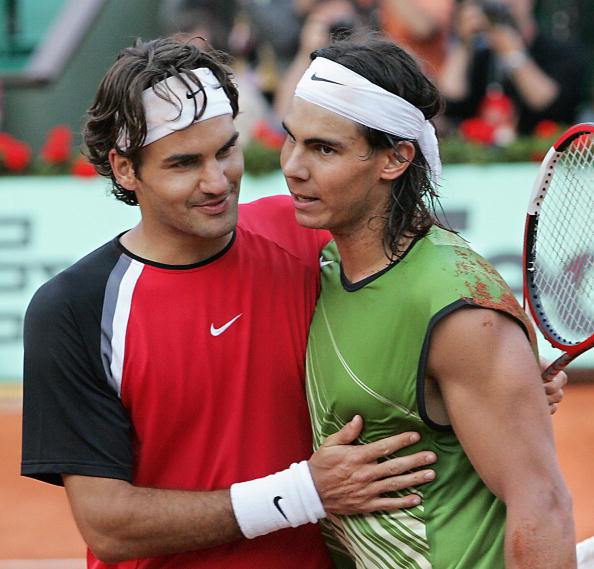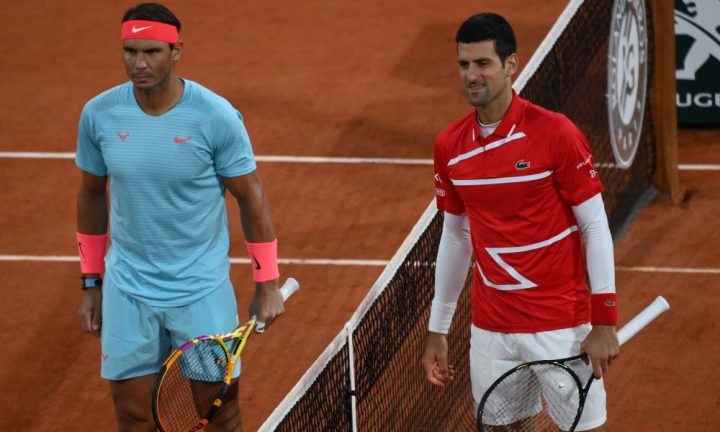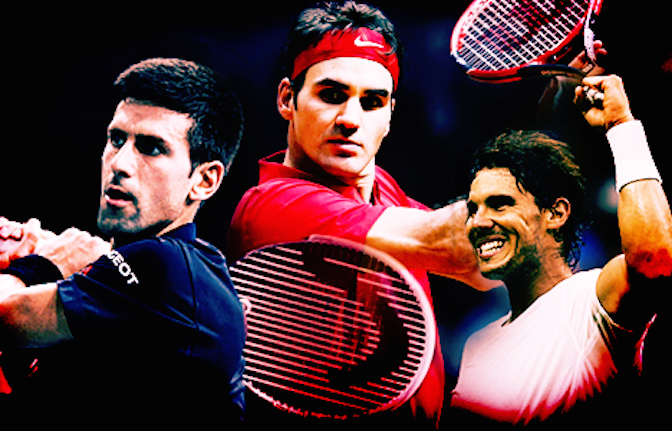We are glad to announce that Steve Flink, the 2017 International Tennis Hall of Fame inductee and long-time tennis insider, has joined the Ubitennis team. He will be writing two monthly long-form features on some of the most relevant topics in world tennis, starting today with a prediction on who will end up winning the most Slam titles among Djokovic, Federer and Nadal.
The greatest players in the game of tennis set themselves apart with their supreme craftsmanship, extraordinary artistry and astonishing match playing acumen. They are superior athletes, top of the line competitors and outstanding individuals who know how to achieve with the force of their wills, the strength of their minds and the depth of their commitment. They are better than anyone else because they find the taste of defeat intolerable and they can handle almost unbearable pressure with both equanimity and creativity.
Enter Roger Federer, Rafael Nadal and Novak Djokovic, a trio of icons who have thoroughly captured the imagination of the sporting public collectively for nearly two decades, comprehensively dominating the sport with their enduring exploits as commendably as it can be done. Think of it: Federer and Nadal now stand together at the top of the men’s list for most major singles titles won with 20 each, while Djokovic is only narrowly behind his two chief rivals with 18. Federer is 39 years old, Nadal 34, and Djokovic 33, but it hardly seems to matter; all three are impenetrable and, in many ways, ageless. They have battled ferociously against “Father Time”, and still remain the pace setters of the sport at the biggest tournaments.
After Djokovic recently secured his ninth Australian Open title to close the gap between himself and his renowned Swiss and Spanish rivals, sports fans everywhere across the globe started focussing with renewed vigor on the fascinating race for historical supremacy at the uniquely prestigious Grand Slam events among these towering performers. It made all of us reexamine the race, project what might be coming, and look at who will eventually stand atop the tennis mountain when all is said and done.
But before offering my prognosis on how this will all play out, let me reflect on what has transpired over the years that has brought us to this juncture. The past is not entirely prologue, but it is well worth considering in determining what the future might hold for this incomparable trio.
By the end of 2005—when Djokovic was already No. 83 in the world but still only 18 and not yet an authentic contender for majors—Federer had already collected six Grand Slam titles. He had taken his first major at Wimbledon in 2003, adding three of the premier crowns in 2004, and then capturing two more in 2005. That was the year when Nadal at 19 claimed his first major at Roland Garros, and so, even though he was five titles behind his Swiss rival, the dynamic Spanish left-hander was officially on the board and in the chase.

Three years later, at the end of 2008, Federer had widened his lead over Nadal. He now owned 13 major crowns, while Nadal had lifted his total to five yet trailed Federer by an even wider margin than was the case only a few years earlier. Nonetheless, after taking his fourth title at Roland Garros that year, Nadal at last succeeded somewhere else at the Grand Slam Championships, toppling Federer on the lawns of the All England Club in an epic 2008 final to take the world’s premier title at Wimbledon for the first time.
That was surely a pivotal moment not only in the Nadal-Federer rivalry, but also within the realm of the sport. Federer had won Wimbledon five years in a row up until then, but Nadal had overcome the world’s best grass court player on his favorite turf. Meanwhile, Djokovic made his mark during that 2008 season in Melbourne, taking his first title at the Australian Open, claiming his maiden major in the process. That, too, was a landmark moment in tennis history, and clearly a sign of things to come for the charismatic Serbian.
Let’s move on to the end of 2011, when Djokovic celebrated a spectacular season which included triumphs at three of the four Grand Slam events. He had commenced that campaign magnificently, sweeping 41 matches in a row before Federer upended him in the semifinals at Roland Garros.
With that groundbreaking 2011 season, Djokovic now had four Grand Slam titles in his collection but Federer and Nadal stood far above him with 16 and 10 respectively. Remarkably, in 2009, Federer had broken Pete Sampras’s record of 14 men’s majors with his sixth Wimbledon title run. But Federer won only one major in 2010 and none at all in 2011. Nadal picked up five in a three year span to finish 2011 closer to Federer but still well behind the Swiss. And yet, both Federer and Nadal knew that Djokovic was now unmistakably and irrevocably in the hunt. It was still inconceivable then that Djokovic could ever catch up with Federer, but astute followers of the game knew that Djokovic was just beginning to explore his full potential.

The fact remained that Djokovic picked up only three more majors from 2012-2014—less than many astute observers anticipated. Nadal amassed four majors across that three year period, while Federer took just one Grand Slam title in that span—Wimbledon in 2012. And so the count stood this way when the curtain closed on 2014: Federer 17, Nadal 14, and Djokovic 7.
Consider where things stood at the end of 2017. That season Federer and Nadal divided the four majors while Djokovic had a difficult season. In 2015 and on into 2016, Djokovic had established himself as the first man to win four majors in a row since Rod Laver won his second Grand Slam in 1969. He won three majors in 2015 and two more in 2016 but then suffered with elbow issues in 2017 and was unable to add to his collection. By the time 2017 ended, Federer had climbed to 19, Nadal had amassed 16 and Djokovic held 12 of the big prizes. The cognoscenti of tennis was fixated on the race between Federer and Nadal. They were a pair of revitalized competitors who were climbing regally through history, but well aware that Djokovic was making inroads.
Nevertheless, since Nadal is five years younger than Federer, there was a growing feeling that he was the man who might eventually equal or surpass Federer at the majors. Djokovic was struggling physically. Most authorities believed that the Serbian was destined to conclude his career in third place on the all time list, likely to pass Sampras eventually yet a long shot to overcome Federer and Nadal.
But look at what has happened since. Djokovic had surgery on the elbow, but by the middle of 2018 he was once more at the top of his game and back in the flow of winning when it mattered the most. He secured the Wimbledon and U.S. Open titles in 2018, added two more majors in 2019, and has now been victorious at the last three Australian Open Championships.
He has been the champion at six of the last ten majors, raising his total of career Grand Slam titles to 18. Nadal, meanwhile, tied Federer at 20 last autumn with his 13th French Open triumph. The Spaniard’s consistency—most prominently at Roland Garros—has been his greatest virtue. He set a men’s record by securing at least one major for ten years in succession (2005-2014). In 14 of the previous 16 seasons, from 2005-2020, he took one or more majors. He has earned his place right alongside Federer at the top of the list. The Swiss Maestro, however, has been out of circulation at the majors since he lost to Djokovic in the semifinals of the 2020 Australian Open. Prior to that, he had two match points in the 2019 Wimbledon final before falling short against Djokovic in a blockbuster, bowing gallantly in a fifth set tie-break played at 12-12. He had missed out on a golden opportunity to oust both Nadal and Djokovic in the same Grand Slam tournament, a feat he has never realized.
Federer will return soon in Doha after more than a year away from the game following two knee surgeries. He must never be underestimated. In 2017, he returned from another knee surgery and, after six months away from the game, stunned Nadal in the final of the Australian Open, spectacularly winning five games in a row from 1-3 in the fifth set to seal the crown. Later that year, he won his eighth Wimbledon title to set a men’s record and then, at the start of 2018, defended his Australian Open crown.
That was Federer’s third triumph in his last four Grand Slam tournaments (he skipped the 2017 French Open) and the Swiss was on a glorious run. But now he faces the reality of turning 40 in August and coming back after a long hiatus. He might well bypass Roland Garros again and pour all of his energy and inspiration into winning Wimbledon for the ninth time and thus secure a 21st major.
As the most natural grass court player in the world and a champion utterly determined to flourish once more when it counts the most, Federer must be taken seriously in London. And that could be his last best chance to prevail at a major tennis tournament. I would not put it past him to win this year on the Wimbledon lawns.
And yet, as prodigious as he remains, the odds are against Federer winning any more majors. But that is not the case, of course, with both Nadal and Djokovic.

The Spaniard will be a huge favorite in June to win Roland Garros for the fifth year in a row and the 14th time overall. He would then move ahead of Federer for the first time and lengthen his career lead over Djokovic at the four majors to three titles. Djokovic has worked inordinately hard to move within two titles of his premier rivals, and a Nadal victory in Paris (which I fully expect) would put an added burden on Djokovic at both Wimbledon and the U.S. Open. Djokovic would sorely need to win at least one of those two tournaments. Prevailing at both will be difficult, but not impossible. He has won five Wimbledon titles altogether, including the last two times he played there in 2018 and 2019. At the U.S. Open, Djokovic has not exploited his opportunities nearly as well, losing five of his eight finals in New York.
My prediction is for Djokovic to win one more major this year at Wimbledon, and thus remain two behind Nadal. He would then be only one behind Federer in this compelling historical chase. In my view, Nadal will conclude the 2021 campaign with 21 majors and Djokovic will stand at 19.
What happens then? To be sure, 2022 will be crucial for both the Spaniard and the Serbian. I believe Djokovic has a very good chance to take his tenth Australian Open title, and will once more make a big push at Wimbledon and the U.S. Open. The view here is that he will capture two majors (the Australian and U.S. Opens) during the 2022 season. The question is this: will Nadal win a 15th French Open? If he does, (and I say he will) the two great players would be separated by one major title heading into 2023 as Nadal gets to 22 and Djokovic makes it to 21 next year.
The view here is that 2023 could well be the last big year for both superstars. Nadal will turn 37 in June of that year; Djokovic reaches 36 in May. They must make the most of their openings. I am guessing that Nadal will finally lose again at Roland Garros and that he will not win any of the “Big Four” titles in 2023. Djokovic, however, will find a way to secure two more majors at Wimbledon and the U.S. Open. That would be a tall order for the Serbian, but I believe he can realize that feat.
So there you have it. Djokovic will conclude his career with 23 majors and Nadal will settle for 22. Federer should remain at 20. Would that resolve, once and for all, the G.O.A.T (Greatest of All Time) debate? Not necessarily. First of all, neither Rod Laver nor Pete Sampras can be overlooked in that debate. Laver won two Grand Slams, achieving that feat in 1962 and 1969. Sampras spent a record six consecutive years at No. 1 (1993-98) in the world and competed in an era when there was a greater diversity of playing styles in the upper regions of the sport, and yet he won 14 of 18 finals at the Grand Slam events. In my view, Sampras at his best indoors and on hard and grass courts is a better player than anyone who has ever lifted a racket.
Can we judge Federer, Nadal and Djokovic solely on their numbers at the major tournaments? The answer, emphatically, is no. Djokovic currently holds a 29-27 career head to head lead over Nadal and has a 27-23 record against Federer. Those figures matter. That strengthens the Serbian’s case. A feather in the cap of Federer is his astounding consistency. He has won 103 tournaments overall in his career while Nadal has amassed 86 and Djokovic 82. I doubt either Nadal or Djokovic will ever catch up to Federer. The larger question is: can Federer can move past Jimmy Connors, who owns an Open Era record 109 career titles? I doubt Federer will surpass Connors, but he has an outside chance. Federer once reached 23 consecutive semifinals at the majors (2004-2010) in his prime and made it to at least the quarterfinals in 36 straight majors (2004-2013). That is an unmatched standard of enduring excellence.
Djokovic will break Federer’s record for most weeks at No. 1 in the world next week when he goes to 311, and, if he can finish 2021 at No. 1, he would be the first man ever to end seven years stationed at the top. And what of Nadal? No one has ever dominated so comprehensively on a surface as he has on clay. So only time will tell where these three great men end up on the historical ladder of tennis. Meanwhile, we can all marvel at this trio as they make more history, inspire us with their heroics and wrap up their shining careers.
Steve Flink has been reporting full time on tennis since 1974, when he went to work for World Tennis Magazine. He stayed at that publication until 1991. He wrote for Tennis Week Magazine from 1992-2007, and has been a columnist and writer for tennis.com and tennischannel.com for the past 14 years. Flink has written four books on tennis including “Dennis Ralston’s Tennis Workbook” in 1987; “The Greatest Tennis Matches of the Twentieth Century” in 1999; “The Greatest Tennis Matches of All Time” in 2012; and “Pete Sampras: Greatness Revisited”. The Sampras book was released in September of 2020 and can be purchased on Amazon.com. Flink was inducted into the International Tennis Hall of Fame in 2017.






